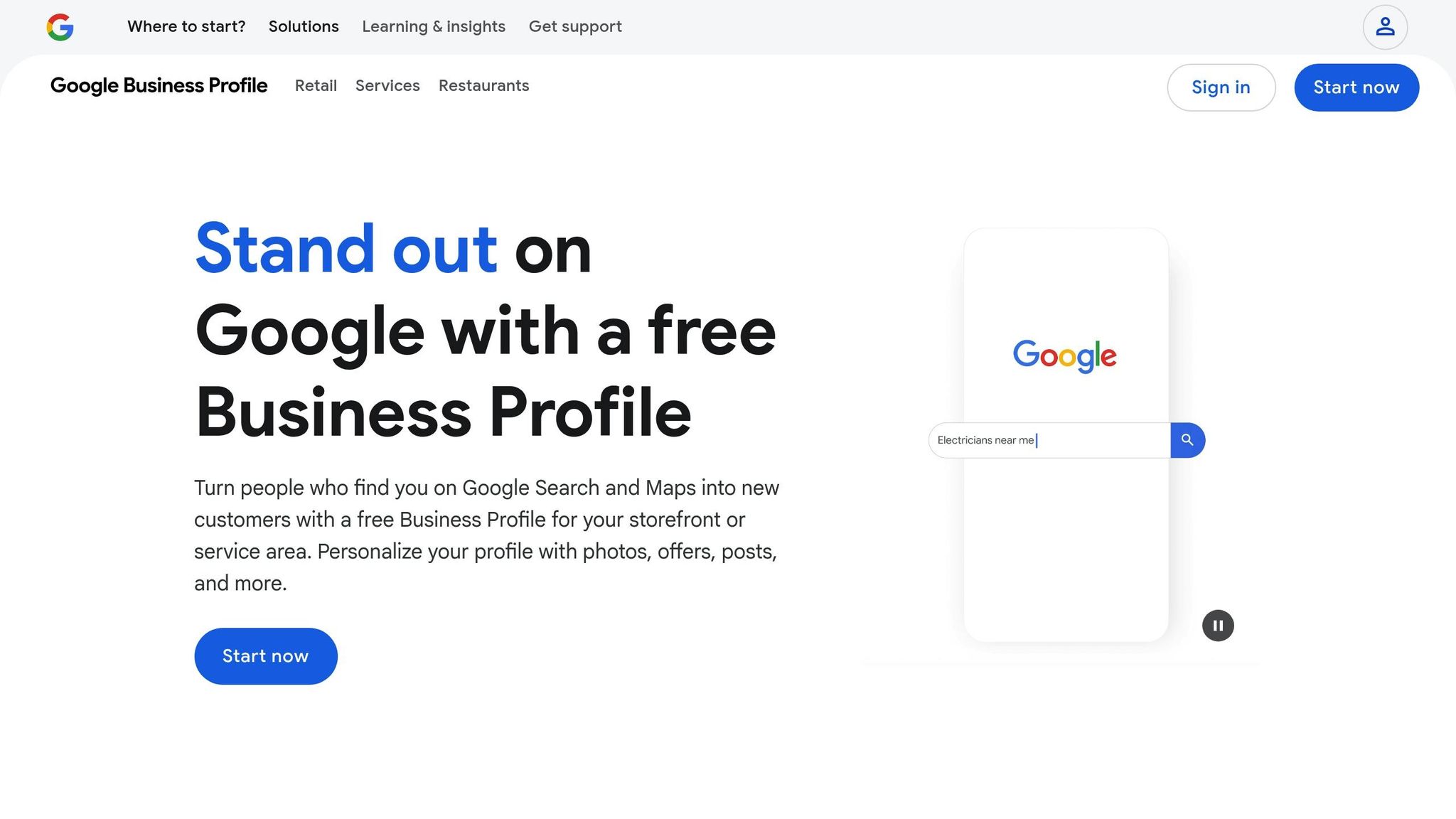Customer reviews are a game-changer for businesses in Austin looking to improve their local SEO. They directly influence search rankings and help build trust with potential customers. Here’s why reviews matter and how they can help your business stand out:
- Boost Visibility: Reviews are a key factor in Google’s local search rankings, especially for searches like "best BBQ in South Austin" or "plumber near me."
- Drive Conversions: 78% of local mobile searches lead to a purchase. Positive reviews can tip the scales in your favor.
- Enhance Engagement: Reviews impact user behavior, driving clicks, and increasing interactions, which further improves rankings.
- Adapt to AI Features: Google’s AI tools now rely on reviews to highlight businesses in search results.
Advanced Local SEO: Turn Bad Reviews Into Ranking Power
How Reviews Impact Local SEO Rankings
Customer reviews play a crucial role in building trust and improving Google’s local search rankings.
Reviews in Google’s Local Pack Algorithm
Google pays close attention to several review-related factors, including star ratings, the number of reviews, and how recent they are. In fact, review signals contribute about 9% to local pack rankings. Businesses that consistently receive a steady stream of reviews tend to perform better in local search results.
Take this for example: top-performing multi-location businesses average 404 reviews. Maintaining a flow of fresh, naturally written reviews can significantly enhance a business’s visibility.
Google’s E-E-A-T framework – focused on Experience, Expertise, Authoritativeness, and Trustworthiness – also leans heavily on review sentiment to gauge a business’s credibility.
These algorithm-driven preferences don’t just affect rankings – they also shape how potential customers interact with your listing.
How Reviews Affect User Behavior Metrics
Reviews do more than influence algorithms – they directly impact user behavior. Positive reviews drive clicks, increase engagement, and boost conversions, all of which send strong signals to Google that your business is relevant and valuable.
Studies show that the tone and sentiment of reviews significantly affect both search engine rankings and customer decisions. Modern search features, often powered by AI, also use review data to highlight businesses, further increasing their visibility.
Here’s how it works: strong reviews lead to higher click-through rates and better conversions. This creates a feedback loop – better reviews improve engagement, which then boosts your local search rankings. For businesses in Austin and beyond, this synergy between user behavior and algorithmic factors offers a competitive edge.
Optimizing Google Business Profile with Reviews

Your Google Business Profile plays a major role in improving local search visibility, especially in a competitive market like Austin. Including customer reviews as part of your profile not only strengthens your local SEO efforts but also encourages greater customer interaction. By aligning your review strategy with your profile optimization, you create a powerful tool for both visibility and engagement.
Key Review Signals for Google Business Profile
Google assesses your business’s prominence by analyzing factors like star ratings and the number of reviews you’ve gathered. Profiles with a high volume of positive reviews tend to rank better in local search results, making reviews a critical part of your local SEO strategy.
How Reviews Appear in Search Results and Map Pack
In Google’s local pack – the section showcasing top local businesses for a search query – your star rating and total review count are displayed prominently beneath your business name. This visibility can directly impact whether users choose to click on your listing. To put it in perspective, 86% of consumers rely on Google Maps to find local businesses. Additionally, Google’s expanded search features and AI-driven tools may showcase snippets from reviews, offering potential customers quick insights into your services at a glance.
Building a Review Generation Strategy for Austin Businesses
Gathering customer reviews isn’t just about asking – it’s about when and how you ask. For businesses in Austin, a well-thought-out review strategy can lead to a steady stream of feedback, which plays a key role in improving local SEO over time.
When and How to Request Reviews
Timing matters. Customers are most likely to leave reviews when their positive experience is still fresh. To make the most of this, incorporate review requests into your sales or service process. Here’s how:
- Right after the transaction: Ask for reviews immediately after a purchase or service. This captures their impressions while the experience is still top of mind.
- Follow-up emails: Sending a thank-you email within 24–48 hours of service completion is another effective way to request reviews. Including a direct link to your review page makes it even easier for customers to respond.
- In-person requests: Train your staff to spot happy customers and ask for reviews during checkout or after service. For example, you can print QR codes on receipts that link directly to your Google Business Profile review section.
- Live chat follow-ups: If you use live chat on your website, ask for a review at the end of a positive interaction.
However, don’t be tempted to offer incentives for reviews. Google explicitly prohibits this practice. As stated in Google Business Profile Help:
"Reviews and other user contributions to Google Maps must reflect a genuine experience. Offering incentives, such as discounts on goods or services, in exchange for a review, a change to an existing review, or the removal of a negative review is strictly prohibited."
Instead, focus on delivering exceptional service that naturally encourages customers to share their experiences. By making the process simple and timely, you can turn great interactions into glowing reviews.
Making the Review Process Simple
Simplicity is key to getting more reviews. The easier it is for customers, the higher the chances they’ll follow through.
- Use direct links: Provide URLs that take customers straight to your review page, eliminating unnecessary steps.
- Add QR codes: Include QR codes on receipts, business cards, or signage to make leaving a review as easy as scanning with a smartphone.
- Optimize for mobile: Many customers will use their phones to leave reviews, so ensure your links work seamlessly across devices and browsers.
- Provide clear instructions: A quick visual guide or a few simple steps can help first-time reviewers navigate the process.
Every extra step or click reduces the likelihood of a customer completing a review. By removing these barriers, you can encourage more feedback, which not only strengthens your reputation but also helps your business stand out in Austin’s competitive market.
Responding to Reviews to Boost SEO Value
Replying to reviews isn’t just good customer service – it’s also a smart way to improve your local SEO. It shows search engines that your business is active and engaged, which can help boost your local search rankings. For businesses in Austin, this kind of engagement can make a real difference in standing out in local search results.
Every response you post strengthens your online presence. It’s an opportunity to reinforce your brand while naturally weaving in SEO keywords. The key is to keep your responses genuine and meaningful.
How to Respond to Positive Reviews
Positive reviews are golden opportunities – not only to thank customers but also to enhance your SEO.
- Make it personal. Start by addressing the reviewer by name if possible. A simple touch like "Thanks, Sarah!" makes your response feel more genuine and thoughtful than a generic "Thanks for the review."
- Highlight specific details. If a customer mentions something specific, reference it in your reply. For example, if they rave about a "kitchen remodel in South Austin", you could say: "We’re so glad you loved your kitchen remodel! The quartz countertops and open layout were such a fun project to work on". This also helps incorporate relevant keywords naturally.
- Reinforce your brand’s values. Use your reply to subtly remind people what your business stands for. If customer service is your strength, mention your commitment to satisfaction. If quality craftsmanship is your focus, highlight that.
- Incorporate keywords naturally. If a customer praises their "master bath renovation using marble tile", echo those terms in your response. For example: "It was a pleasure bringing your vision to life! The marble tile in your master bath turned out beautifully". Always keep the tone conversational and natural.
Handling Negative Reviews Professionally
Negative reviews might sting, but they’re also a chance to show professionalism and build trust with both potential customers and search engines.
- Respond promptly and professionally. A quick, respectful reply shows that you’re actively monitoring feedback and care about resolving concerns. This kind of engagement signals to Google that your business is attentive, which can positively influence local rankings.
- Stay consistent in managing reviews. Regularly responding to reviews – whether positive or negative – helps maintain your credibility and visibility in local search results. This is especially important for staying competitive in a market like Austin.
"Asking for and responding to reviews so Google and customers see your business as active and trustworthy." – Steve Soto, Partner & CTO, The Breezy Company
Using Reviews Across Local SEO Channels
Customer reviews are incredibly influential when it comes to earning trust – not just with potential customers but also with search engines. In a city like Austin, where competition can be fierce, showcasing reviews effectively can elevate your local SEO game. By embedding reviews on your website, you not only strengthen your credibility but also send positive signals to search engines, which can improve your local search rankings. Let’s dive into how you can make the most of these reviews on your website.
Adding Reviews to Your Website
Your website is one of the best places to highlight customer reviews. Featuring them directly on your site does more than just enhance your reputation – it also reinforces your local SEO efforts. For Google, these reviews act as trust indicators, complementing other optimization strategies you’ve implemented. By integrating reviews seamlessly, you create a more robust and effective local SEO approach that can help your business stand out in Austin’s competitive market.
Monitoring and Measuring Review Performance
Keeping an eye on how your reviews are performing is just as important as gathering them in the first place. Without consistent monitoring, you miss out on valuable insights that could elevate your Austin business’s local SEO game. Reviews aren’t just about reputation – they reveal how satisfied your customers are, send trust signals to search engines, and highlight areas where your business can improve. This analysis builds on the review collection strategies discussed earlier.
"Reviews influence more than reputation – they impact search rankings and conversions too. A higher number of positive reviews improves your visibility, and Google considers them as a trust signal in its local algorithm." – Blueprint Digital
The key is knowing which metrics to focus on. By zeroing in on the right data, you can make smarter decisions that directly boost your local search rankings.
Key Metrics to Track Review Performance
Start by tracking review volume and frequency. A steady stream of new reviews is critical for maintaining strong local SEO. Search engines value recency, so consistently gathering fresh feedback should be a core part of your strategy.
Next, keep a close eye on your average star rating across platforms like Google Business Profile, Yelp, and Facebook. This metric not only influences search rankings but also plays a major role in shaping customer decisions. If your rating starts to dip, it’s a clear signal to address potential customer service or operational issues immediately.
Another important metric is review response time. How quickly you reply to reviews matters – both to your customers and to search engines. A fast response time shows you’re actively engaged with your audience. Aim to respond to reviews within 24 hours whenever possible, and track your average response speed to ensure you’re staying on top of this.
Using Review Data for Business Improvement
Beyond just tracking, reviews can provide actionable insights to improve your business. The language customers use in their feedback often mirrors the keywords they search for online. Pay attention to recurring phrases or terms in your reviews – they can be goldmines for optimizing your content.
For example, if customers frequently mention "quick service" or "friendly staff", these phrases can be incorporated into your website copy or your Google Business Profile description. Real customer language often resonates better in local search results than generic marketing terms.
Additionally, take note of what customers praise most often. Use this feedback to refine your services and adjust your marketing messages to emphasize what you’re already doing well. Reviews aren’t just about responding – they’re about learning and growing.
Conclusion: Turning Reviews into a Competitive Advantage in Austin
Customer reviews aren’t just a bonus – they’re a cornerstone of local SEO success in Austin’s highly competitive market. Each positive review you gather not only boosts your visibility in search results but also builds trust with potential customers and signals to Google that your business is active and dependable within the local community.
Austin businesses that thrive understand the importance of managing reviews consistently. Encouraging feedback, responding promptly, and using insights from reviews are proven ways to enhance search rankings and foster customer loyalty.
Take this example: a local mobile detailing business saw its monthly revenue jump from $10,000 to $25,000 simply by focusing on active review management. Similarly, a dog daycare center expanded its client base from 45 to over 900 in less than a year, with more than 90% of new customers coming from their online SEO efforts.
Optimizing your Google Business Profile, requesting reviews strategically, responding professionally to feedback, and regularly monitoring your reviews can set you apart. While competitors may falter with inconsistent online efforts, you’ll be attracting customers who trust your proven track record.
Ready to take action? Start by asking a happy customer for a review, update your Google Business Profile, and keep an eye on your review performance. In Austin’s competitive market, businesses that excel in review management lead the pack in local search results and win over more customers.
FAQs
What are the best ways to encourage customers to leave reviews without offering incentives?
Encouraging customers to share reviews without offering incentives begins with providing exceptional service that inspires them to talk about their experience. After a successful interaction, kindly ask for a review – timing is crucial, so make your request while the experience is still fresh in their minds.
Simplify the process by offering clear instructions or sharing direct links to your review platforms, like your Google Business Profile. Always express gratitude by thanking customers for their feedback, whether it’s glowing praise or constructive criticism. Responding quickly shows you value their opinions and are attentive to their input.
How can I respond to negative reviews to improve my business’s local SEO in Austin?
Responding thoughtfully to negative reviews can do more than just manage your reputation – it can also give your local SEO in Austin a boost. The key is to approach each review with professionalism and empathy. Start by acknowledging the customer’s concerns and offering a genuine apology, even in situations where you feel the issue wasn’t entirely your fault. This shows that you value their feedback and are willing to address their experience.
Make your response personal and specific. Use the customer’s name and reference details from their review to show you’ve taken the time to understand their concerns. Offer a clear and actionable solution, like a refund, a discount, or an invitation to discuss the matter privately. Throughout your response, maintain a calm and respectful tone – steer clear of defensive or overly emotional language.
To give your response an SEO edge, try to naturally incorporate relevant keywords, but don’t overdo it. After resolving the issue, follow up with the customer to ensure they’re satisfied. If the situation improves, you might politely ask if they’d consider updating their review. These steps not only reflect your dedication to great customer service but also help strengthen your online visibility.
How do customer reviews affect my business’s ranking in Google’s local search results?
Customer reviews are a major factor in how visible your business is in Google’s local search results, including the highly sought-after local pack (those top three map-based listings). A steady flow of recent, positive reviews can give your business an edge, as Google sees these as signals of trustworthiness and relevance.
On top of that, taking the time to respond to reviews – whether they’re glowing or critical – can strengthen your credibility with potential customers. Engaging with reviews not only supports your local SEO efforts but also makes it more likely that searchers will choose your business. By staying on top of your reviews and using them strategically, you can improve both your online presence and customer confidence.




